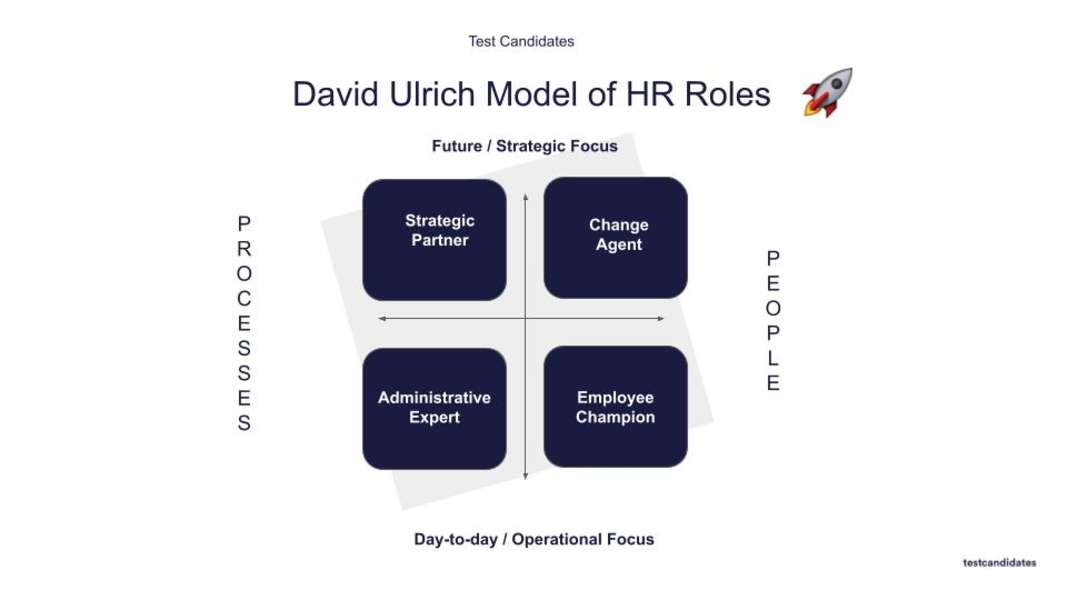The David Ulrich HR model is used by big, customer-focused companies around the world to improve efficiency and efficacy in their HR departments.
Ulrich's model helps to organize roles and responsibilities across HR departments, defining who is responsible and accountable for the key tasks that contribute to the smooth running of any business.
What is The David Ulrich HR model?
The Ulrich model of HR is a model that helps to organize roles and responsibilities across HR departments. This HR model was first introduced by David Ulrich in 1995 as a way of organizing HR functions.
Meant particularly for large corporations with big and unwieldy teams, the model is designed to streamline ways of working and ensure every team member is clear on their roles and responsibilities, and what they're accountable for.
Ulrich splits HR into four key sections:
Strategic Partner. The Strategic Partner is there to help manage the development and growth of the workforce. They look to the customer to see what they could make better, and they review the systems and processes that might help to deliver what the customer wants and needs more efficiently.
Administrative Expert. The Administrative Expert has more of an internally focused role. They manage costs, people, and the overall delivery of the day-to-day 'business as usual' output.
Change Agent. The Change Agent looks into the company's overall culture and thinks about how it can be better, both from a personal and professional perspective. They'll connect with line managers to lead and facilitate change to make the organization a better place for everyone.
Employee Champion. The Employee Champion aids employees to speak up and ensures they feel heard and respected at work. They support the delivery of processes and practicalities that ensure safeguarding, and they can also help to make sure the company's people are happier and healthier, which is of huge overall benefit to the organization.
This sets up the framework for a high-functioning HR department and clearly defines which roles should be focused on people and processes. Within those roles, it states whether each individual should be looking at operational or strategic planning.
The core goals attached to the model are to:
- Create a high-functioning and unified team structure
- Define every role in the department
- Ensure the company is performing to its best and operating competitively
- Measure performance to consistently do better
The model was particularly revolutionary at the time as it put talent sourcing and future-thinking firmly on the radar, and showed them to be as significant as the more traditional HR roles of employee assistance and administrative tasks.
Who is David Ulrich?
David Ulrich is a university professor, author, speaker, management coach, and thought leader in HR.
He was born in Nevada in 1953 but grew up in Oregon. Ulrich attended Birmingham Young University where he studied University Studies, before earning a Ph.D. in Business Organisation Theory.
The focus of Ulrich's professional career has been strategic leadership and human resources practices, and his HR books have helped thousands of businesses to address internal structure issues, make positive changes and improve productivity and effectiveness.
Among many other topics, he's helped to shape thinking in aligning HR practices to customer needs, the outcomes of effective leadership, and how investing in leadership can increase shareholder value.
In the human resources world, David Ulrich is considered a guru, even though many now argue that his theories are becoming increasingly outdated in a modern, technology-focused world. The fundamental principles of his work continue to help many companies organize their HR function in a way that better supports both people and processes.
Is the David Ulrich HR model still relevant?
When Ulrich's HR model came out, HR departments were not generally as efficient and forward-thinking as they are now and there was certainly a need for a foundation on which to base and build a team on.
These days, HR teams in big businesses tend to run like well-oiled machines; delivering both the everyday output that ensures people feel supported and well looked after, while also proactively looking to the future by sourcing talent, working on strategies, and helping to stay one step ahead of the competition.
A lot may have changed in terms of landscape, but the Ulrich model still has a great deal of importance and relevance for modern businesses. Especially those with HR departments that recognize it as a useful foundation, and can build on it in a way that works for the particular needs of their business.
Core Principles
Ulrich's HR model provided clarity of focus that greatly improved the efficiency of HR departments in thousands of large-scale companies, which ultimately helped to improve the customer experience.
Splitting the workforce into four key areas (Strategic Partner, Administrative Expert, Change Agent, and Employee Champion) helped to define roles and responsibilities and ensured things like safeguarding, employee satisfaction, and the future of the company were not being neglected in favor of more traditional HR tasks.







